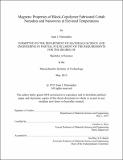| dc.contributor.advisor | Caroline A. Ross. | en_US |
| dc.contributor.author | Hernandez, Juan J. (Juan Jose), S.B. Massachusetts Institute of Technology | en_US |
| dc.contributor.other | Massachusetts Institute of Technology. Department of Materials Science and Engineering. | en_US |
| dc.date.accessioned | 2015-09-17T17:42:13Z | |
| dc.date.available | 2015-09-17T17:42:13Z | |
| dc.date.copyright | 2015 | en_US |
| dc.date.issued | 2015 | en_US |
| dc.identifier.uri | http://hdl.handle.net/1721.1/98554 | |
| dc.description | Thesis: S.B., Massachusetts Institute of Technology, Department of Materials Science and Engineering, 2015. | en_US |
| dc.description | This electronic version was submitted by the student author. The certified thesis is available in the Institute Archives and Special Collections. | en_US |
| dc.description | Cataloged from student-submitted PDF version of thesis. | en_US |
| dc.description | Includes bibliographical references (page 41). | en_US |
| dc.description.abstract | Patterned media on the nanometer scale are useful for electrical, optic, and magnetic applications such as memory storage. Using block copolymer fabrication methods, 60nm diameter cobalt nanodots and 37nm wide cobalt nanowires were created, both with heights of 20nm. To characterize the reliability of the nanodots, magnetic hysteresis loops of three samples, Co5 Co7 and Co9, were taken at elevated temperatures up to 350°C Comparing room temperature magnetization to the ideal magnetization, percent of surface covered in nanodots was calculated to be 88%, 50%, and 60% respectively for each sample. The trends of magnetization per square centimeter and coercivity with temperature both suggest 2 mechanisms are involved in decreasing the magnetic properties of the nanodots; oxidation occurring below 200°Cand microstructure rearrangement occurring above 200°C The depth of oxide growth on the nanodots was calculated to be 2nm deep on the surface of the nanodots when below 200°Cand no more than 10nm deep when above 200°C Activation volume calculations could not be accurately calculated, suggesting an activation volume 10!! times the volume of one nanodots. To characterize magnetic features present in the nanowires from block copolymer fabrication, magnetic force microscopy images were taken of direct and alternating demagnetized samples for a qualitative analysis. Counting magnetic features showed direct demagnetized samples had more 50% domain walls, with the domain walls mainly located on junctions and curves. Alternating demagnetized samples had fewer domain walls and these were predominantly located in straight lines. | en_US |
| dc.description.statementofresponsibility | by Juan J. Hernandez. | en_US |
| dc.format.extent | 41 pages | en_US |
| dc.language.iso | eng | en_US |
| dc.publisher | Massachusetts Institute of Technology | en_US |
| dc.rights | M.I.T. theses are protected by copyright. They may be viewed from this source for any purpose, but reproduction or distribution in any format is prohibited without written permission. See provided URL for inquiries about permission. | en_US |
| dc.rights.uri | http://dspace.mit.edu/handle/1721.1/7582 | en_US |
| dc.subject | Materials Science and Engineering. | en_US |
| dc.title | Magnetic properties of block-copolymer fabricated cobalt nanodots and nanowires at elevated temperatures | en_US |
| dc.type | Thesis | en_US |
| dc.description.degree | S.B. | en_US |
| dc.contributor.department | Massachusetts Institute of Technology. Department of Materials Science and Engineering | |
| dc.identifier.oclc | 920678240 | en_US |

